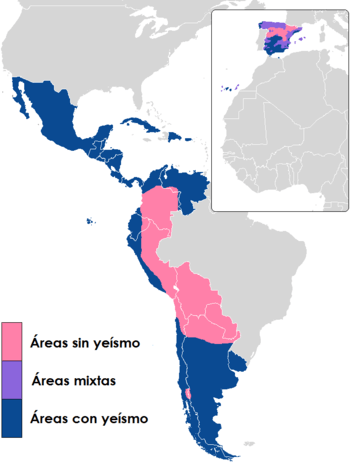Yeísmo

Yeísmo (Spanish pronunciation: [ɟʝeˈizmo]) is a distinctive feature of many dialects of the Spanish language, which consists of the loss of the traditional palatal lateral approximant phoneme /ʎ/ (written ⟨ll⟩) and its merger into the phoneme /ʝ/ (written ⟨y⟩), usually realized as a palatal approximant or affricate. It is an example of delateralization.
In other words, ⟨ll⟩ and ⟨y⟩ represent the same sound /ʝ/. The term yeísmo comes from the Spanish name of the letter ⟨y⟩ (ye[1]). Now, over 90% of Spanish dialects exhibit this phonemic merger. [2] Similar mergers exist in other languages, such as Italian, Hungarian, Catalan, Portuguese or Galician, with different social considerations.
Occasionally, the term lleísmo (pronounced: [ʎeˈizmo]) has been used to refer to the maintenance of the phonemic distinction between /ʝ/ (spelled "y") and /ʎ/ (spelled "ll").[3][4][5]
Pronunciation
Most dialects that merge the two sounds represented by ⟨ll⟩ and ⟨y⟩ realize the remaining sound as a voiced palatal fricative [ʝ], which is similar to the ⟨y⟩ in English your, but it sometimes sounds like ⟨j⟩ in English jar, especially after /n/ or /l/ or at the beginning of a word. For example, relleno is pronounced [reˈʝeno] and conllevar is pronounced [koɲɟ͡ʝeˈβaɾ] or [koɲdʒeˈβaɾ].
In most of Argentina and Uruguay, the sound is pronounced [ʒ];[6] but in Buenos Aires, the sound has recently been devoiced to [ʃ] among younger speakers.[7]
Extent of yeísmo and lleísmo
Yeísmo has always been common in much of Latin America, mainly in lowlands, and in large areas in Spain.
The distinction between /ʝ/ and /ʎ/ remains in the Philippines, Ecuadoran highlands, Andean Peru, Paraguay, most of Bolivia and the northeastern portions of Argentina that border with Paraguay. [8] The distinction is more common in areas with a common bilingualism with indigenous languages, such as Aymara and Guaraní.[9] In Spain, most of the northern half of the country and several areas in the south used to retain the distinction, but yeísmo has spread throughout the country, and the distinction is now lost in most of Spain, particularly outside areas with linguistic contact with Catalan and Basque.[10]
Minimal pairs
Yeísmo produces homophony in a number of cases. For example, the following word pairs sound the same to speakers of dialects with yeísmo, but they would be minimal pairs in regions with lleísmo:
- haya ("beech tree" / "that there be") ~ halla ("s/he finds")
- cayó ("s/he fell") ~ calló ("s/he became silent")
- hoya ("pit, hole") ~ olla ("pot")
- baya ("berry") / vaya ("that he go") ~ valla ("fence")
The relatively low frequency of both /ʝ/ and /ʎ/ makes confusion unlikely. However, orthographic mistakes are common (for example, writing llendo instead of yendo). A similar effect took place in the local name of the island of Majorca: Mallorca is a continental Catalan hypercorrection of the earlier Maiorca.[11]
Other languages
Similar phenomena occurred in other languages.
In Hungarian, /ʎ/ turned into /j/, but the spelling ly was preserved, hence lyuk (Hungarian pronunciation: [juk]).
In French, /ʎ/ turned into /j/, but the spelling ll was preserved, hence briller (French pronunciation: [bʁije]).
In the rural Caipira dialect of Brazilian Portuguese, /ʎ/, orthographically ⟨lh⟩, merged into /j/. For example, the word mulher, "woman", pronounced /muˈʎɛɾ/ in general Brazilian, becomes /muˈjɛ/ in Caipira.
See also
- Rioplatense Spanish
- History of the Spanish language
- List of phonetics topics
- Phonological history of Spanish coronal fricatives (distinción, seseo and ceceo)
References
- ↑ "La "i griega" se llamará "ye"" Cuba Debate. 2010-11-05. Retrieved 25 November 2010.
- ↑ Coloma (2011), p. 103.
- ↑ Álvarez Menendez (2005), p. 104.
- ↑ Schwegler, Kempff & Ameal-Guerra (2009), p. 399.
- ↑ Travis (2009), p. 76.
- ↑ Martínez-Celdrán, Fernández-Planas & Carrera-Sabaté (2003), p. 258.
- ↑ Lipski (1994), p. 170.
- ↑ Coloma (2011), p. 95.
- ↑ Lapesa, Rafael. "El español de América" (in Spanish). Cultural Antonio de Nebrija.
- ↑ Coloma (2011), pp. 110–111.
- ↑ Diccionari català-valencià-balear, Institut d'Estudis Catalans (look up the term "Mallorca")
Bibliography
- Álvarez Menéndez, Alfredo I (2005), Hablar en español: la cortesía verbal, la pronunciación estándar del español, las formas de expresión oral, Universidad de Oviedo
- Coloma, German (2011), "Valoración socioeconómica de los rasgos fonéticos dialectales de la lengua española.", Lexis, 35 (1): 91–118
- Lipski, John (1994), Latin American Spanish, New York: Longman Publishing
- Martínez-Celdrán, Eugenio; Fernández-Planas, Ana Ma.; Carrera-Sabaté, Josefina (2003), "Castilian Spanish", Journal of the International Phonetic Association, 33 (2): 255–259, doi:10.1017/S0025100303001373
- Navarro, Tomás (1964), "Nuevos datos sobre el yeísmo en España" (PDF), Thesavrvs: Boletín del Instituto Caro y Cuervo, 19 (1): 1–117
- Torreblanca, Máximo (1974), "Estado actual del lleísmo y de la h aspirada en el noroeste de la provincia de Toledo", Revista de dialectología y tradiciones populares, 30 (1-2): 77–90
- Schwegler, Armin; Kempff, Juergen; Ameal-Guerra, Ana (2009), Fonética y fonología españolas, John Wiley & Sons, ISBN 0470421924
- Travis, Catherine E. (2009), Introducción a la lingüística hispánica, Cambridge University Press
Further reading
- Pharies, David (2007). A Brief History of the Spanish Language. University of Chicago Press. ISBN 978-0-226-66683-9.